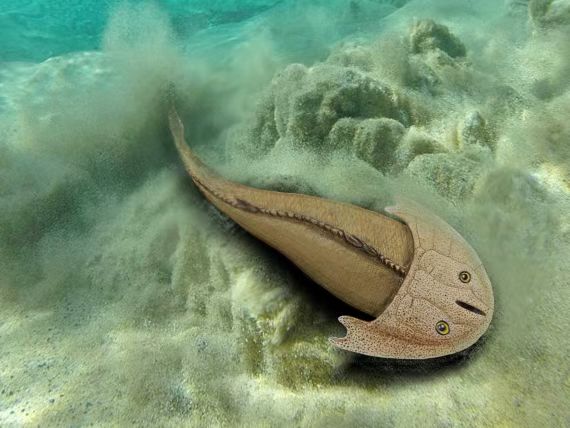Culture & Entertainment
တရုတ်နိုင်ငံ၌ နှစ်သန်းပေါင်း ၄၀၀ ကျော်သက်တမ်းရှိသော ငါးကျောက်ဖြစ်ရုပ်ကြွင်း တွေ့ရှိ

ချုံချင့်၊ မတ် ၄ ရက် (ဆင်ဟွာ)
တရုတ်နိုင်ငံ အနောက်တောင်ပိုင်း ချုံချင့် မြူနီစီပယ်၊ Xiushan Tujia နှင့် Miao ကိုယ်ပိုင်အုပ်ချုပ်ခွင့်ရကောင်တီ၌ လွန်ခဲ့သောနှစ်သန်းပေါင်း ၄၃၆ သန်းခန့်က ရေှးဟောင်းငါးမျိုးစိတ်ဝင်များ၏ ကျောက်ဖြစ်ရုပ်ကြွင်းတစ်ခုကို တူးဖော်တွေ့ရှိခဲ့ကြောင်း သိရသည်။
“Binhai Yongdong ငါး ” သို့မဟုတ် Yongdongaspis littoralis ဟုအမည်ရသော ရှေးဟောင်းငါးသည် မေးရိုးမဲ့ငါးအမျိုးအစား တစ်ခုဖြစ်ကြောင်း သိရသည်။ ၄ စင်တီမီတာ မှ ၅ စင်တီမီတာသာရှည်လျားသော ၎င်းငါးသည် အရှေ့အာရှတွင် ေတွ့ရလေ့ရှိပြီး ပင်လယ်ရေတိမ်ပိုင်းနှင့် ကမ်းရိုးတန်းပတ်ဝန်းကျင်တွင် အဓိကနေထိုင်ကြကြောင်း ချုံချင့် မြူနီစီပယ်၊ စီမံကိန်းနှင့် သဘာဝအရင်းအမြစ်ဗျူရိုက မတ် ၄ ရက်တွင် ပြောကြားခဲ့သည်။
ရှေးဟောင်းငါးမျိုးစိတ်အသစ်များကို ရှာဖွေတွေ့ရှိခြင်းသည် မေးရိုးမဲ့ငါးအမျိုးအစား ၏ ဆင့်ကဲဖြစ်စဉ်အတွင်း အသွင်ကူးပြောင်းသည့် အဆင့်အချို့ကို ပြသရာ၌ အထောက်အကူဖြစ်စေကြောင်း ချုံချင့် ဘူမိဗေဒနှင့် ဓာတ်သတ္တုအရင်းအမြစ်ဌာန၏ စာတမ်းအား ပထမဆုံးရေးသားသူနှင့် အကြီးတန်းအင်ဂျင်နီယာ Chen Yang က ပြောကြားခဲ့သည်။
အဆိုပါ ငါးတည်ရှိခဲ့သော Silurian ကာလသည် ကမ္ဘာ့ဆင့်ကဲဖြစ်စဉ်၏ အရေးကြီးသောကာလဖြစ်သည်။ ထိုကာလအတွင်း ကမ္ဘာသည် သမုဒ္ဒရာအနီရောင်ကြမ်းပြင်ဖြစ်ပေါ်စေခဲ့သည့် ပြင်းထန်သော ဘူမိဗေဒဆိုင်ရာ လှုပ်ရှားမှုများ ကြုံတွေ့ခဲ့ရကြောင်းသိရသည်။ကျောက်ဖြစ်ရုပ်ကြွင်းများကို လံုလောက်စွာ တွေ့ရှိမှု အားနည်းခြင်းကြောင့်လည်း သမုဒ္ဒရာအနီရောင်ကြမ်းပြင်၏ ဘူမိဗေဆိုင်ရာ သက်တမ်းကို အတိအကျဖော်ပြရန်မှာ မဖြေရှင်းနိုင်သော ပဟေဠိတစ်ခုအဖြစ် ကျန်ရှိနေကြောင်း သိရသည်။
ချုံချင့်တွင် တွေ့ရှိရသော ၎င်းကျောက်ဖြစ်ရုပ်ကြွင်းသည် တရုတ်နိုင်ငံတောင်ပိုင်း၏ သမုဒ္ဒရာအနီရောင်ကြမ်းပြင်အပေါ်လွှာအား ထပ်ဆင့်ခွဲခြားခြင်းနှင့် ဆက်စပ်မှုကို အထောက်အထားအသစ် ပ့ံပိုးပေးမည်ဟု မျှော်လင့်ကြောင်း တရုတ်သိပ္ပံအကယ်ဒမီ၏ ကျောရိုးရှိသတ္တဝါကျောက်ဖြစ်ရုပ်ကြွင်းဗေဒနှှင့် လူသားကျောက်ဖြစ်ရုပ်ကြွင်းဗေဒဆိုင်ရာ ပါမောက္ခ Zhu Min ၏ ပြောကြားချက်အရ သိရသည်။ (Xinhua)
…………………………………………
(English Version)
Over 400-mln-yr-old fossil of fish found in China
CHONGQING, March 4 (Xinhua) — A fossil of an ancient fish species living about 436 million years ago has been uncovered in Xiushan Tujia and Miao Autonomous County, southwest China’s Chongqing Municipality.
The ancient fish named “Binhai Yongdong fish,” or Yongdongaspis littoralis, is a type of Galeaspida. Only 4 to 5 cm long, the fish was endemic to East Asia and mainly lived in shallow sea and coastal environments, said the municipal planning and natural resources bureau on Friday.
The discovery of the new ancient species can help exhibit some transitional states during the evolution of Galeaspida, said Chen Yang, first author of the paper and senior engineer of the Chongqing Institute of Geology and Mineral Resources.
The Silurian period in which the fish existed was a critical period of the earth’s evolution. During the period, the planet underwent violent geological tectonic movements which formed marine red beds. Due to the lack of sufficient fossils found, the exact geological age of the red beds remains an unsolved mystery.
The fossil found in Chongqing is expected to provide new evidence of the subdivision and correlation of the Upper Red Beds in southern China, according to Zhu Min, professor of the Institute of Vertebrate Paleontology and Paleoanthropology, Chinese Academy of Sciences. Enditem
